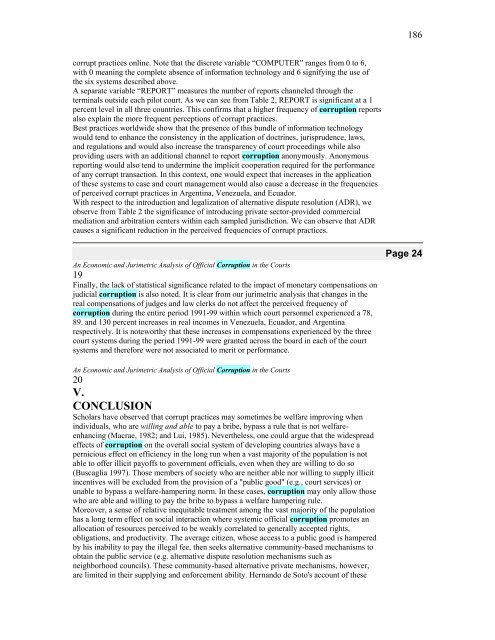FILSAFAT KORUPSI - Direktori File UPI
FILSAFAT KORUPSI - Direktori File UPI
FILSAFAT KORUPSI - Direktori File UPI
You also want an ePaper? Increase the reach of your titles
YUMPU automatically turns print PDFs into web optimized ePapers that Google loves.
corrupt practices online. Note that the discrete variable “COMPUTER” ranges from 0 to 6,<br />
with 0 meaning the complete absence of information technology and 6 signifying the use of<br />
the six systems described above.<br />
A separate variable “REPORT” measures the number of reports channeled through the<br />
terminals outside each pilot court. As we can see from Table 2, REPORT is significant at a 1<br />
percent level in all three countries. This confirms that a higher frequency of corruption reports<br />
also explain the more frequent perceptions of corrupt practices.<br />
Best practices worldwide show that the presence of this bundle of information technology<br />
would tend to enhance the consistency in the application of doctrines, jurisprudence, laws,<br />
and regulations and would also increase the transparency of court proceedings while also<br />
providing users with an additional channel to report corruption anonymously. Anonymous<br />
reporting would also tend to undermine the implicit cooperation required for the performance<br />
of any corrupt transaction. In this context, one would expect that increases in the application<br />
of these systems to case and court management would also cause a decrease in the frequencies<br />
of perceived corrupt practices in Argentina, Venezuela, and Ecuador.<br />
With respect to the introduction and legalization of alternative dispute resolution (ADR), we<br />
observe from Table 2 the significance of introducing private sector-provided commercial<br />
mediation and arbitration centers within each sampled jurisdiction. We can observe that ADR<br />
causes a significant reduction in the perceived frequencies of corrupt practices.<br />
An Economic and Jurimetric Analysis of Official Corruption in the Courts<br />
19<br />
Finally, the lack of statistical significance related to the impact of monetary compensations on<br />
judicial corruption is also noted. It is clear from our jurimetric analysis that changes in the<br />
real compensations of judges and law clerks do not affect the perceived frequency of<br />
corruption during the entire period 1991-99 within which court personnel experienced a 78,<br />
89. and 130 percent increases in real incomes in Venezuela, Ecuador, and Argentina<br />
respectively. It is noteworthy that these increases in compensations experienced by the three<br />
court systems during the period 1991-99 were granted across the board in each of the court<br />
systems and therefore were not associated to merit or performance.<br />
An Economic and Jurimetric Analysis of Official Corruption in the Courts<br />
20<br />
V.<br />
CONCLUSION<br />
Scholars have observed that corrupt practices may sometimes be welfare improving when<br />
individuals, who are willing and able to pay a bribe, bypass a rule that is not welfare-<br />
enhancing (Macrae, 1982; and Lui, 1985). Nevertheless, one could argue that the widespread<br />
effects of corruption on the overall social system of developing countries always have a<br />
pernicious effect on efficiency in the long run when a vast majority of the population is not<br />
able to offer illicit payoffs to government officials, even when they are willing to do so<br />
(Buscaglia 1997). Those members of society who are neither able nor willing to supply illicit<br />
incentives will be excluded from the provision of a "public good" (e.g., court services) or<br />
unable to bypass a welfare-hampering norm. In these cases, corruption may only allow those<br />
who are able and willing to pay the bribe to bypass a welfare hampering rule.<br />
Moreover, a sense of relative inequitable treatment among the vast majority of the population<br />
has a long term effect on social interaction where systemic official corruption promotes an<br />
allocation of resources perceived to be weakly correlated to generally accepted rights,<br />
obligations, and productivity. The average citizen, whose access to a public good is hampered<br />
by his inability to pay the illegal fee, then seeks alternative community-based mechanisms to<br />
obtain the public service (e.g. alternative dispute resolution mechanisms such as<br />
neighborhood councils). These community-based alternative private mechanisms, however,<br />
are limited in their supplying and enforcement ability. Hernando de Soto's account of these<br />
186<br />
Page 24

















